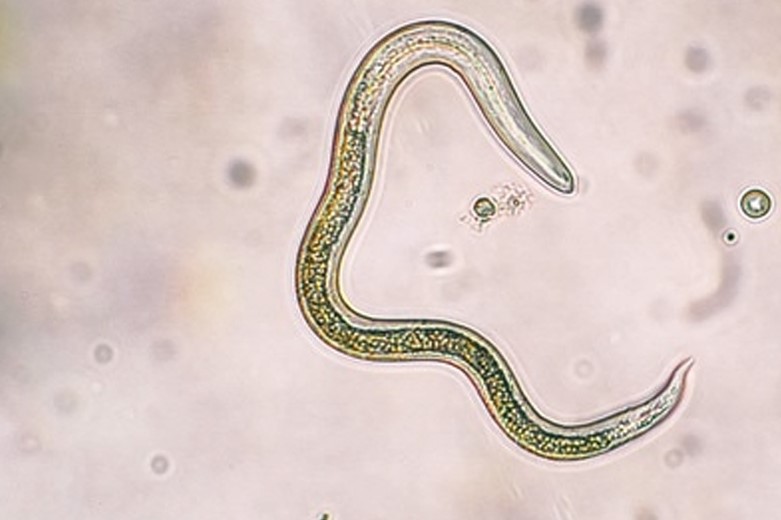
Toxocariasis: the zoonosis transmitted by the nematodes Toxocara canis or Toxocara cati
Toxocariasis is a larval infestation transmitted by animals. Although it is widespread throughout the world, it is more frequent in developing countries
Toxocariasis is a zoonosis, i.e. a disease transmitted by animals (dogs, cats and other animals), and is also known as visceral larva migrans
Although it is widespread throughout the world, the prevalence is higher in developing countries in both animals and people.
It is an infection caused by certain worms, specifically the larvae of the nematodes Toxocara canis or Toxocara cati, which grow in dogs and cats respectively, and which can accidentally infect humans.
Dogs and cats, through their faeces, disperse the parasite eggs into the environment, which can be ingested by humans, especially children, who are more easily exposed to the soil and tend to carry contaminated hands and objects to their mouths.
Once in the human body, the eggs hatch in the intestine, releasing the larvae, which are able to penetrate the intestinal wall and migrate to various tissues, including the liver, lungs, central nervous system and eyes.
The eggs of nematodes of the Toxocara genus can also be ingested by other mammals, such as rabbits or sheep, and humans can become infected by consuming the meat of these animals, raw or undercooked.
The main clinical manifestations of Toxocariasis are the visceral migrant larva and the ocular migrant larva
In the visceral migrant larva, which mainly affects pre-school children, the larvae invade several tissues: liver, lungs, skeletal muscles, heart.
They cause the following symptoms: fever, muscle pain (myalgia), weight loss, cough, rash, hepatosplenomegaly (enlarged spleen). Migration to the central nervous system is rare and may cause eosinophilic meningoencephalitis.
In the migrating ocular larvae, the larvae produce various ophthalmological lesions.
Involvement is unilateral (affecting only one eye) and visual damage usually presents as uveitis, retinitis or endophthalmitis.
Permanent visual damage or blindness may occur.
More severe forms are rare and depend on larvae migrating through tissues, where they are able to cause bleeding, formation of inflammatory nodules of fibrous tissue (granulomas), and tissue death (necrosis).
If neglected and in frail children, the disease can give complications such as respiratory failure, cardiac arrhythmias and brain damage.
Diagnosis requires:
- A thorough examination with a history of the places the child has frequented and whether or not he or she has been exposed to contaminated objects;
- Assessment of symptoms;
- Blood tests showing hyperglobulinemia, leucocytosis and eosinophilia, but above all the presence of antibodies against the parasite must be confirmed;
- A direct, but invasive, diagnostic method consists of taking a tissue sample (biopsy) that is examined for larvae or the resulting inflammation (usually liver). However, larvae are difficult to find in tissue sections and biopsies have a low yield.
Examination of faeces is, on the other hand, useless in humans, as adult egg-laying worms cannot be found.
Examination of the faeces of infested pets can, on the contrary, support the diagnosis.
There is no effective and proven cure.
Treatment is usually not necessary, but symptoms can be treated and anti-parasitic drugs and corticosteroids can be used.
Available and effective anti-parasitic drugs are albendazole and mebendazole.
They are recommended for patients with moderate to severe symptoms.
In addition, when symptoms are severe or the infection has affected the eyes, the administration of corticosteroids may be essential.
Antihistamines may be sufficient in the case of mild symptoms.
Occasionally, laser photocoagulation (application of an intense light beam) is used to kill the larvae in the eyes.
The prognosis of Toxocariasis is good and the disease has a limited duration, between 6 and 18 months
From a practical point of view, it is of course necessary to follow the most basic rules of hygiene:
- Wash hands before eating and discourage children from bringing their hands to their mouth or face;
- Discourage children from ingesting non-food substances such as soil and clay;
- Frequent public gardens and apartment blocks with particular care: these are highly contaminated and contaminating areas.
In the event that the child has a pet such as a dog or cat at home, it is advisable to
- Worm the animal quarterly, following the instructions of your veterinarian;
- Cover the cat’s litter box;
- Wash food bowls thoroughly with warm water.
The incidence of this disease could be drastically reduced if pet owners conscientiously eradicated worms from their animals (by worming them) and removed faecal material left by their pets especially in yards, playgrounds or recreational areas.
Read Also
Emergency Live Even More…Live: Download The New Free App Of Your Newspaper For IOS And Android
Toxoplasmosis: What Are The Symptoms And How Transmission Occurs
Toxoplasmosis, The Protozoan Enemy Of Pregnancies
Managing Chickenpox In Children: What To Know And How To Act
Monkeypox Virus: Origin, Symptoms, Treatment And Prevention Of Monkey Pox
Leptospirosis: Transmission, Diagnosis And Treatment Of This Zoonosis
Parasitoses And Zoonoses: Echinococcosis And Cystic Hydatidosis


